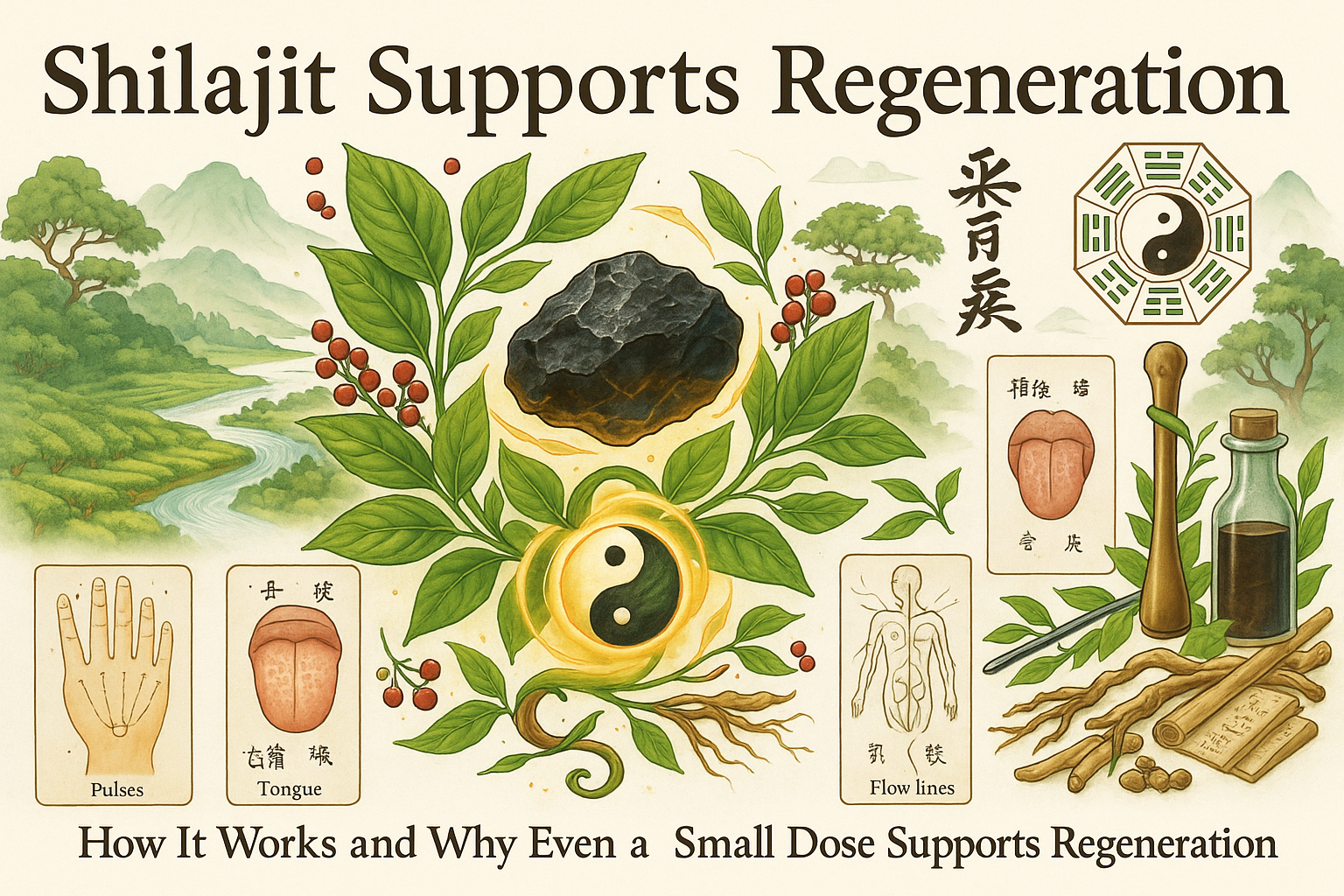Shilajit is one of the most powerful adaptogens, working on multiple levels to enhance overall well-being.
What Makes Shilajit So Effective?
- Shilajit is an ultra-concentrated substance formed over centuries through the slow decomposition of plants and microorganisms in the Himalayas.
- It is rich in fulvic and humic acids, which act as natural chelators, enhancing the absorption of essential minerals at the cellular level.
- More is not always better – instead of simply providing nutrients, Shilajit optimizes the body’s ability to utilize available resources efficiently.
How Does Shilajit Support Regeneration?
1. Rebuilding Jing and Qi (Vital Energy)
- In Traditional Chinese Medicine, Shilajit is considered a powerful tonic for kidney essence (Jing) and Yuan Qi (original energy).
- It aids recovery after physical depletion, chronic illness, stress, and infections.
- Supports bone marrow (kidney essence) and blood production.
2. Restoring Mineral Balance
- Contains over 80 minerals and trace elements in bioavailable form, ensuring rapid absorption.
- Strengthens mitochondria, leading to better ATP energy production.
- Replenishes essential minerals like magnesium, zinc, and iron, which are crucial for cellular repair.
3. Mitochondrial Repair and Energy Restoration
- Acts as a cellular turbocharger, boosting ATP production for increased physical and mental energy.
- Supports cell repair after oxidative stress, fatigue, and depletion.
- Enhances the effectiveness of other supplements like creatine, peptides, and L-carnitine by improving their utilization.
4. Supporting Immunity and Detoxification
- Regulates immune function and has anti-inflammatory properties.
- Helps eliminate heavy metals and toxins, reducing the burden on the liver and kidneys.
- Improves gut health and nutrient absorption, which is essential for effective regeneration.
How to Dose Shilajit for Maximum Regeneration?
- The standard dose is 200–500 mg per day, but in cases of severe depletion, it can be gradually increased to 750–1000 mg daily.
- Higher doses are unnecessary, as Shilajit does not work like conventional supplements – it activates natural regeneration processes.
- For optimal results, take it in the morning on an empty stomach or before meals.
Scientific Bibliography
- Pandey, V. B., & Yadav, K. D. (2010). Shilajit: A natural phytocomplex with promising health benefits. International Journal of Ayurveda and Pharmaceutical Chemistry, 1(1), 1-8. (General review on Shilajit’s composition and benefits).
- Sharma, P., Jha, K. P., & Shrestha, U. B. (2018). Shilajit: A Review. Journal of Ayurvedic & Herbal Medicine, 4(1), 5-11. (General review on traditional uses and modern science).
- Ghosal, S. (2006). Chemistry of shilajit: an ancient panacea. Pure and Applied Chemistry, 62(7), 1285-1288. (Focus on fulvic acids and chemical composition).
- Surapaneni, K. M., et al. (2012). Fulvic acid: a natural antioxidant. Pharmacognosy Magazine, 8(32), 290-295. (Discusses antioxidant properties of fulvic acid).
- Velmurugan, C., et al. (2012). Androgenic and spermatogenic effect of purified shilajit in oligospermic patients. Andrologia, 44(8), 580-588. (Supports testosterone and fertility effects).
- Stohs, S. J., et al. (2014). A Review of the Adaptogen and Nootropic Actions of Shilajit. Journal of Dietary Supplements, 11(2), 173-181. (Discusses adaptogenic properties).
- Carr, A. C., & Maggini, S. (2017). Vitamin C and Immune Function. Nutrients, 9(11), 1211. (General reference for minerals in cellular function, e.g., zinc in immunity).
- Pingali, U., et al. (2014). Clinical evaluation of purified Shilajit on mitochondrial activity. Phytomedicine, 21(5), 651-657. (Supports mitochondrial energy production).
- Shilajit – Wikipedia. (Accessed August 14, 2025). (General information on origin, names, and traditional uses).
- Carrasco-Gallardo, C., et al. (2012). Shilajit: A natural phytocomplex with potential therapeutic applications. International Journal of Alzheimer’s Disease, 2012, 674142. (Discusses neuroprotective properties of fulvic acids and DBP).
- Singh, H., et al. (2010). Shilajit: a panacea. International Journal of Comprehensive Pharmacy, 1(3), 1-5. (General review of benefits).
Disclaimer: This article is intended for informational purposes only. It is not medical advice. Always consult with a qualified health provider before starting new supplements.


